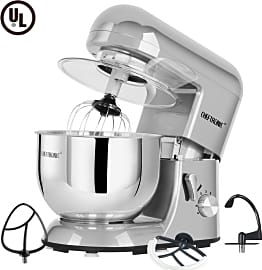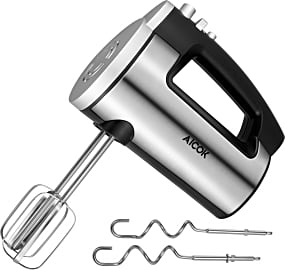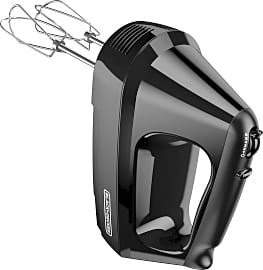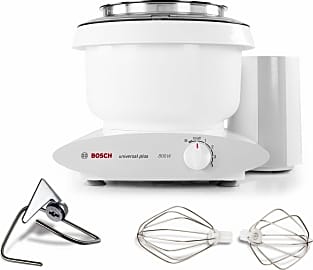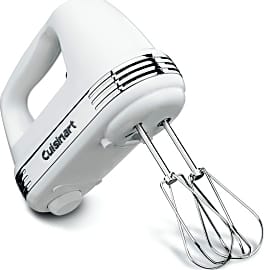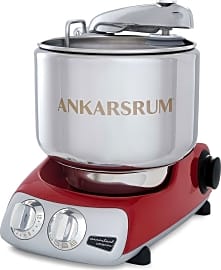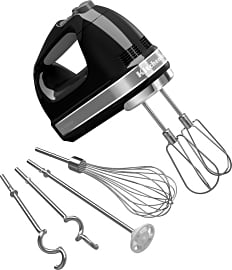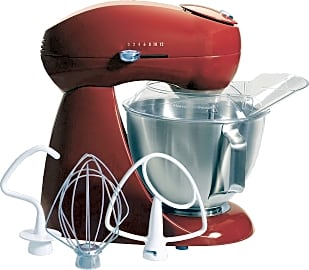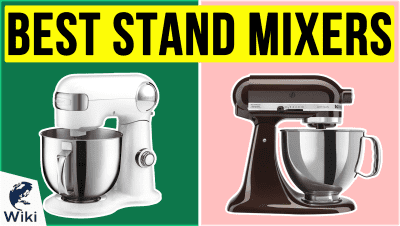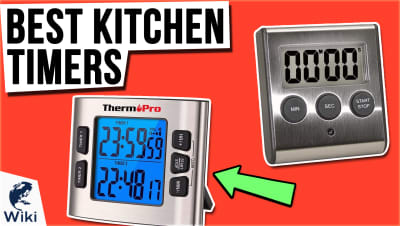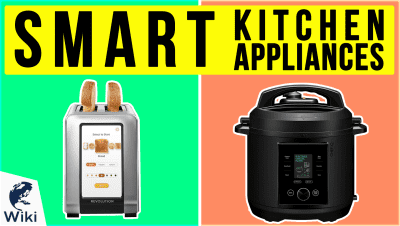The 10 Best Kitchen Mixers

This wiki has been updated 45 times since it was first published in February of 2015. When it comes to cooking food from scratch, whether you are kneading dough, making batter, or creating complex sauces, a kitchen mixer will relieve you of the strenuous part of your prep work. Our selection includes handheld designs suitable for the occasional baker as well as full-featured countertop models good for professional chefs. Any one of them will have you whipping up a feast in no time. When users buy our independently chosen editorial picks, we may earn commissions to help fund the Wiki.
Editor's Notes
November 28, 2019:
Our list of best kitchen mixers features models from reputable brands that are sure to make your prep work quicker and easier. They offer handy attachments like sturdy dough hooks and orbiting beaters that are sure to reach the entire contents of your bowl. Some also feature handy LED status indicators and LCDs for easy control of the settings. Whether you’re looking for a compact, handheld model for occasional baking or for a large, stand-alone one that can prepare large batches of doughs and sauces with ease, our selection offers plenty of options for you.
Retaining its top spot is the KitchenAid Artisan 5-Quart, which is assembled in the U.S. and offers an impressive 10 speed settings for precision mixing. Its tilting head makes it easy to remove your bowl or to look inside at how your dough is coming along. If you purchase the optional attachments, you’ll be well equipped to make not just cookies and cakes, but also pasta, ice cream, sausage, and more.
Moving into the second spot is the Breville Die-Cast, which offers even two more speed settings than the KitchenAid, as well as an LCD that features a handy, count-down timer that automatically shuts off the mixer at the end. Its stainless steel bowl locks firmly in place when it’s in operation, and the base sits firmly on the counter, even when it’s at full tilt.
To see more options for larger models, see or list of the best stand mixers, which are great when you’re making large amounts of cookie dough, homemade pasta, or loaves of bread.
Special Honors
Thermomix TM6 This German multi-functional appliance is a mixer, food processor, blender, slow-cooker, steamer, and more – all wrapped into one. Its goal is to make home cooking nutritious and effortless. It incorporates a heating element, a motor for blending and stirring, and a weighing scale. Other components include a stainless steel bowl and a state-of-the-art mixing knife. It’s about the size of a cappuccino maker and can help ensure that your busy evenings go by smoothly by making healthful dinners more accessible. thermomix.com
A Brief History Of The Kitchen Mixer
Bakeries and commercial kitchens were the target customers, and the machines were large and heavy, with bowl capacities of around 80 quarts.
The earliest mixers were essentially manual egg beaters, which are still available today. The first one was developed in 1856 by a tinsmith in Baltimore named Ralph Collier. It was a hand-cranked device built into a container and intended for beating and aerating eggs.
Other inventors made several improvements on the design over the next few decades. In 1885, the first electric mixer was patented by Rufus Eastman. The title of the patent was "Mixer for Cream, Eggs, and Liquors," and it used a single paddle at the end of a faucet-like tube, powered by a motor. Kitchen appliance companies quickly took note, most notably the Hobart Manufacturing Company, which developed their first freestanding model in 1908, intended for commercial bakeries to use in bread-making. The Sunbeam Corporation was quick to follow suit, with a product called the Mixmaster in 1910.
At first, the market for electric mixers was considered to be primarily industrial. Bakeries and commercial kitchens were the target customers, and the machines were large and heavy, with bowl capacities of around 80 quarts. Hobart's first major customer was the US Navy, which installed their mixers on every vessel in their fleet.
After World War I, the company's executives wanted to experiment with bringing the machines into the residential market, and tested them in their own homes. Legend has it, one executive's wife supposedly responded to the test model by saying "I don't care what you call it, all I know is it's the best kitchen aid I've ever had." Thus, the name KitchenAid was born, and remains attached to the most successful line of kitchen mixers to date.
Spurred on by the enthusiasm from users of the home test models, Hobart ramped up production and introduced the five-quart standing countertop KitchenAid in 1922. While it was lauded for its functionality, the appliance was prohibitively expensive, retailing for around $190 at the time, which equates to well over $2,000 today. Sunbeam competed successfully with Hobart by introducing their own countertop model in 1930, which sold for just $18, over 90 percent cheaper than the KitchenAid.
Its affordability rocketed Sunbeam's MixMaster to popularity, paving the way for stand mixers to become standard equipment in every household kitchen. KitchenAid fired back by introducing their Model K machine in 1936, which sported the same iconic silhouette as the models they still sell today, and retailed for just $55.
Sunbeam released its first handheld mixer in 1952. The companies continued competing throughout the ensuing decades, releasing new products and attempting to outdo one another while simultaneously branching out into other appliance markets. Both remain formidable forces in the industry, though KitchenAid has been leading the mixer market since the mid 50s.
Determining What Kind of Mixer is Right for You
Generally speaking, there are three different kinds of mixers available today, and each one is best suited to different purposes. There is plenty of variation within each category, but this guide should point you in the right direction if you're unsure of what type is right for you.
It'll save you a pretty penny compared to most electric models, and a great deal of time and wrist strain if you're used to using a standard whisk.
An eggbeater is the manual, hand-cranked device that set the stage for the electric mixer to take the world by storm. Though it may be the modern-day version's predecessor, it's far from obsolete. If your primary mixing needs are beating eggs and whipping cream, it's likely the right one for you. It'll save you a pretty penny compared to most electric models, and a great deal of time and wrist strain if you're used to using a standard whisk.
A handheld mixer is useful for whipping up batters and soft doughs. Most versions are portable and inexpensive, with beaters that easily pop out from their powered bases, making them easy to clean and store. Some models come with a variety of attachments, like dough hooks and whisks, though most stick to standard mixing beaters. If you make a lot of cookies and cakes, a handheld electric model will save you lots of time compared to mixing by hand.
The holy grail of kitchen mixers is the standing model, which is designed to be a fixture of your countertop. In most cases, they use removable bowls and attachments, while the weighted base stays in place. This keeps cleanup to a minimum and makes it possible to switch between tasks without having to stop and wash your equipment. Most models include mixing beaters as well as whisk attachments and dough hooks. They come in capacities suited for every kitchen, from those in small apartments to industrial bakeries, with the spinning power to match.
Thanks to their powerful internal motors, many stand mixers can be expanded to serve a variety of non-mixing functions. A front-facing hub on most KitchenAids, for example, allows for the attachment of pasta rollers, meat grinders, and much more. If you'd like to expand your kitchen repertoire in the future, picking up a machine that can grow with you is a smart move.
Some Ways To Use Your Mixer
If you've just purchased a new mixer and aren't quite sure what to do with it, here are a few suggestions beyond the obvious cake batters and cookie doughs.
It'll whip plenty of air into your egg mixture, creating a much frothier consistency than you could achieve by hand.
If you're a fan of scrambled eggs, a mixer with a whisk attachment is an excellent way to ensure fluffiness. It'll whip plenty of air into your egg mixture, creating a much frothier consistency than you could achieve by hand. It works well for frittatas and quiches as well. The same is true of milk and cream. Your mixer can help you can make a batch of fresh whipped cream in minutes, or froth milk for homemade lattes and cappuccinos.
Mashed potatoes are another dish where you might not realize a mixer can come in handy. If you like them smooth, a mixer is hard to beat in terms of the consistency it offers and the time it saves. The same is true of guacamole.
A mixer is also a great tool for making custom ice cream flavors. Just chill the bowl and add store bought ice cream with whatever ingredients you like. From fresh fruit to candy, cookies, and cakes, the possibilities are endless.



